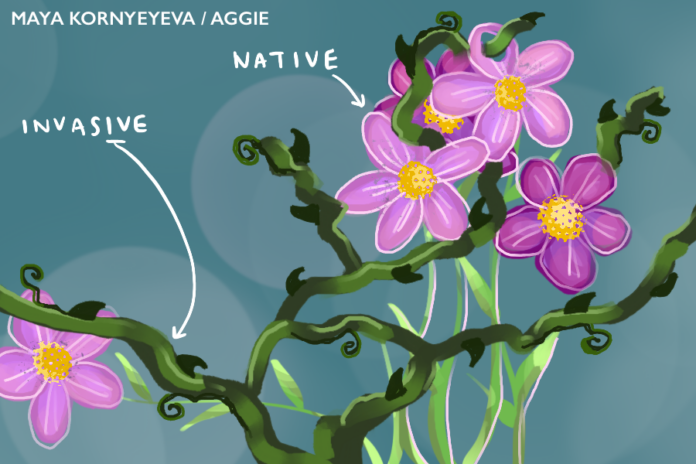UC Davis professor Justin Valliere discusses the impact of urbanized nitrogen deposition on Santa Monica Mountain Airshed
By EVELYN KUEI — science@theaggie.org
After a large wildfire, such as the 2013 Springs Fire in the Santa Monica Mountains, many native species are expected to blossom. However, with recent uprooting from alien and invasive species, our native wildlife cannot sprout.
Since 2011, Justin Valliere, an assistant professor in the UC Davis Department of Plant Sciences, has been working with the National Park Service in the Los Angeles region to investigate the adverse effects of vehicle and urban pollution in the Santa Monica Mountains National Recreation Area.
“The park knew that nitrogen deposition was likely something they were facing,” Valliere said. “However, evaluating it as a risk to native species and for invasions hadn’t been studied yet, so that’s how the project started.”
Valliere and his team used observational studies to study nitrogen deposition naturally without manipulating the environment, along with a controlled experiment in which the researchers deposited known quantities of nitrogen onto different plots of land.
“The physiology of native species has evolved in the context of low nitrogen availability, so in some ways, they don’t know how to behave with added nitrogen,” Valliere said.
Although nitrogen is one of the most essential nutrients for plant growth, too much nitrogen threatens native wildflowers. When exposed to far more significant portions of nitrogen than needed, native plants are overrun by invasive species that benefit from the nitrogen and use it to grow faster.
This added nitrogen can also exacerbate the negative effects of drought on native species. In addition to the nitrogen deposition already caused by vehicle and industry emissions, the dry drought season has also brought many challenges –– including the increased chance of more significant and damaging wildfires.
“In 2013, there was a massive wildfire called the Springs Fire,” Valliere said. “When that happened, it was unexpected, but we realized it would be a cool opportunity to understand how nitrogen deposition does not just impact natives in the park and invasive [species] but how it impacts post-fire recovery.”
Valliere’s recently published research highlights weed damage to coastal sage shrubs and fire-following species in the Santa Monica Mountains. With native species needing more time to bounce back after a drought and fire season, weeds can displace the native flora due to their ability to grow more rapidly.
“This work provides strong evidence that [nitrogen] deposition can exacerbate the negative impacts of other drivers of global environmental change, including extreme drought and nonnative plant invasion,” Valliere’s website reads. “Together, these drivers may contribute to converting native coastal sage scrub to invasive-dominated annual grasslands. Loss of native habitat will further impact native biodiversity and ecosystem services.”
Many fire-following species are only seen after a wildfire, requiring intense heat to sprout. However, with weeds taking over the available space, these flowers can not grow from their seeds and blossom. Valliere is currently focusing on the relationship between dry drought seasons, high nitrogen deposition and the impacts of wildfires.
A study on fire and invasive species in Mediterranean-climate ecosystems of California discusses the factors that contribute to the success of invasive species.
“Alien grasses that invade woody associations often have characteristics that alter the fire regime in ways that favor aliens over the indigenous vegetation,” the study reads. “In their new setting, these alien annuals succeed partly because of their propensity to shift the fire regime away from one that favors shrub reestablishment to one that favors further annual establishment.”
Although the weeds take up the available space, they are more flammable and thus more dangerous. If a fire were to occur under these conditions, it would start faster, become more robust and ultimately cause more damage to our climate and environment.
The threat of larger, more exacerbated wildfires looms over our lives. These wildfires, paired with the takeover of more flammable weedy species, threaten the livelihood of our households and communities and are an ever-growing threat to our planet.
Written by: Evelyn Kuei — science@theaggie.org




